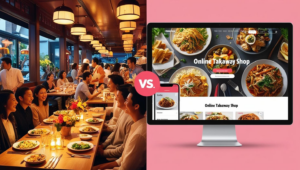
The secret of starting a food and beverage business at ultra-low cost!!!
The food and beverage business has always been a popular choice for entrepreneurs. However, in today’s economic environment, the traditional restaurant model is no longer a cost-effective option. With the prevalence of delivery platforms and cloud kitchens, food and beverage entrepreneurs can enter the market at a lower cost and in a more flexible manner, quickly test their concepts, and reap rewards.
We will analyze in detail why the traditional restaurant model poses high risks and costs, and how the combination of cloud kitchens with delivery platforms has become a better option, supported by data.
Traditional Restaurant Model: High Costs, High Risks, Low Value for Money
- Rental Costs
In Hong Kong, the rental cost of commercial spaces is the biggest burden for entrepreneurs.
- Commercial Shop Rent in Hong Kong: Rental costs in prime locations can range from $50,000 to $300,000+ per month.
- Generally, rental costs account for 20%-40% of the total costs of traditional restaurants.
- High Renovation and Equipment Expenditure
Traditional restaurants require substantial upfront investments:
- Renovation costs: Average of $1,000 – $2,000 per square foot, with costs for medium-sized restaurant renovations reaching $500,000 – $1,000,000.
- Kitchen equipment: Commercial kitchen equipment such as stoves, exhaust hoods, refrigeration equipment, etc., can cost over $200,000 – $400,000.
- In addition to fire permits and food licenses, the additional time and financial costs make the barrier to entry higher.
- Labor Cost Pressure
- In Hong Kong, for example, the average monthly salary for a full-time chef ranges from $20,000 to $40,000, and with waitstaff and cleaners, monthly salary expenses can reach $100,000.
- Labor costs account for 30%-40% of the total operating costs.
- High Risk, Long Payback Period
- The payback period for traditional restaurants typically takes 2-3 years.
- According to a survey in the Hong Kong food industry, 30% of new restaurants close within the first year, and within five years, the closure rate reaches 60%.
- Therefore, newcomers face significant risks.
Cloud Kitchen Model: Low Costs, Low Risks, High Flexibility
Compared to traditional restaurants, cloud kitchens are a revolutionary food and beverage entrepreneurship model. Entrepreneurs do not need to rent commercial spaces, nor do they have to face high renovation, labor, and operational pressures. Here are the advantages of cloud kitchens and how they operate:
- Significantly Lower Rental Costs
Cloud kitchens are shared commercial kitchens designed for deliveries, such as JF Kitchen (www.jfkitchen.hk), providing kitchen space, basic equipment, food manufacturing licenses, and a range of entrepreneurial support services, allowing entrepreneurs to enter the market at the lowest cost and speed.
- JF Kitchen’s pricing plan:
- Approximately $8,500 – $15,000 per month, depending on kitchen size and location.
- Compared to commercial spaces, monthly savings can reach 80%-90% on rental costs.
- Includes kitchen basic equipment, eliminating costly renovation and equipment investments, and the risk of unfinished renovations.
- No Need for Dining Space, Reducing Labor Costs
- Cloud kitchens only require chefs and a small number of logistical staff, eliminating the need for waitstaff and saving a significant amount on labor costs.
- Operational with a small team of 1-3 people, monthly salary expenses can be controlled within $20,000 – $60,000.
- With Delivery Platforms, Rapid Market Entry
- Delivery platforms such as Foodpanda, Deliveroo, and Keeta provide strong ordering systems and delivery networks, allowing food and beverage entrepreneurs to quickly reach a large customer base.
- According to Deliveroo’s data, the Hong Kong delivery market grows by over 15% annually, with a market size exceeding HK$20 billion.
- Reduced Opening Time and Increased Flexibility
- Traditional restaurants may take 6-12 months from site selection to official operation, while cloud kitchens usually only take 1-2 months.
- With no fixed location, entrepreneurs can quickly adjust menus, locations, and operational modes based on market demands.
Data Support: Why Cloud Kitchens Are More Cost-Effective?
Here is a general cost comparison between traditional restaurants and cloud kitchens (using Hong Kong as an example):
| Items | Traditional Restaurant | Cloud Kitchen |
| Rental Costs | $50,000 – $300,000/month | $8,500 – $15,000/month |
| Renovation Expenses | $500,000 – $1,000,000 | $0 (Already renovated and equipped) |
| Labour Costs | $100,000 – $200,000/month | $30,000 – $50,000/month |
| Profit Margins | 12-36 months or longer | Duration varies based on merchants’ operations and methods, ranging from 3 to 6 months or more |
| Closure Risks | High (30% – 60%) | Low (flexible adjustment) |
Example Sharing: How Can Cloud Kitchens Help You Succeed?
Assuming you are using JF Kitchen’s shared kitchen and receiving orders through Keeta, Foodpanda, and Deliveroo:
- The monthly fixed cost (monthly fee + labor) is about $35,000.
- Receiving 80-100 orders per day, with an average gross profit of $30 per order.
Monthly gross profit: 100 orders x 30 days x $30 = $90,000. - After deducting platform commissions and other expenses, the monthly net profit is approximately $25,000-$30,000.
This model has low risk, allows for quick market acceptance testing, and is suitable for startups.
Conclusion: Cloud Kitchens are the Best Choice for Low-Cost Entrepreneurship
In a market environment with high costs and great risks, the traditional restaurant model is no longer suitable for most entrepreneurs. On the other hand, the cloud kitchen model combined with delivery platforms provides a flexible, low-cost, and high-return entrepreneurial opportunity. Especially with shared kitchens like JF Kitchen, which have laid the infrastructure for entrepreneurs, allowing you to focus on creating quality dishes and easily entering the market.
If you dream of starting a business, consider starting from a cloud kitchen, testing the waters at low cost, and growing steadily!
Learn more about JF Kitchen Cloud Kitchen
